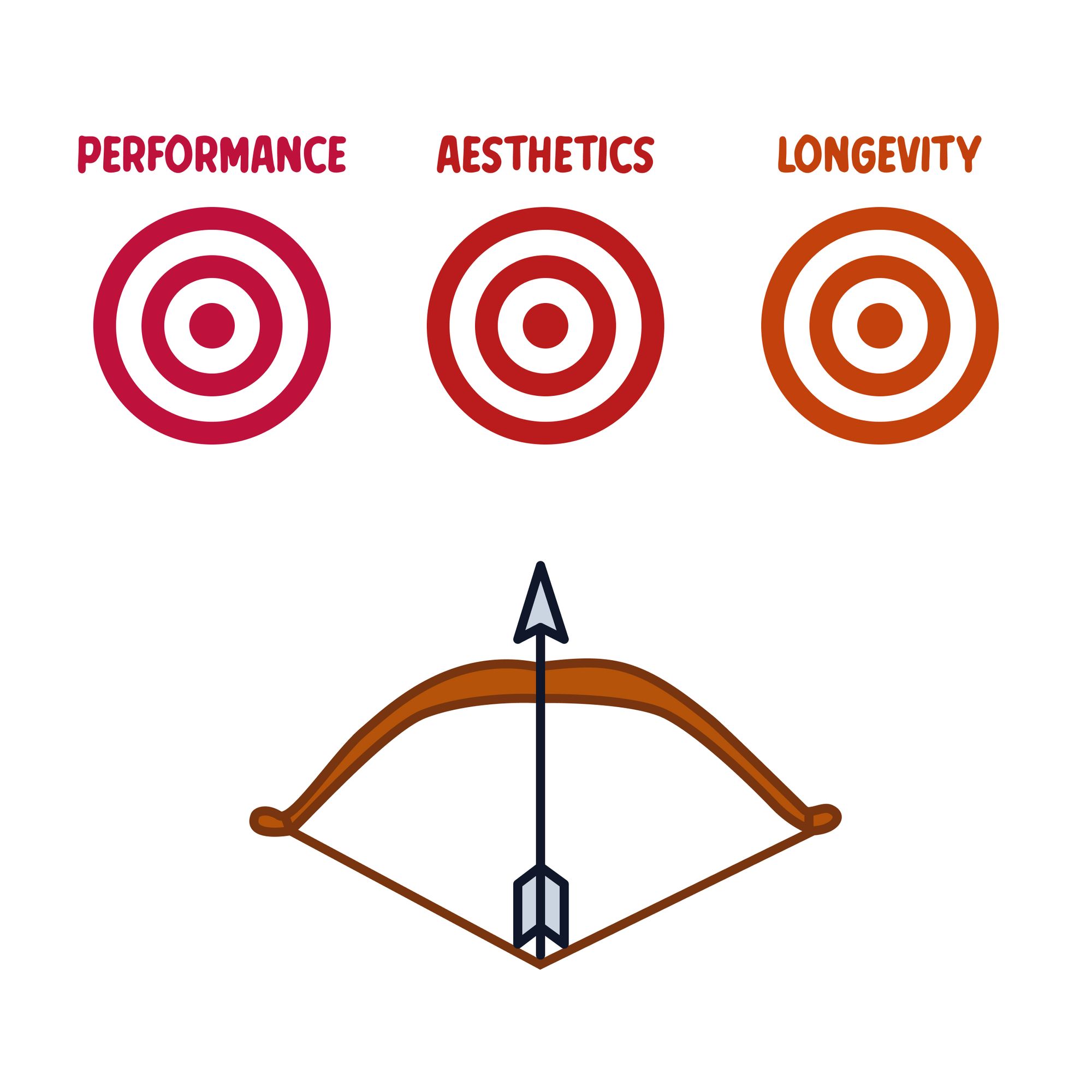Are you eating and training for performance, aesthetics, or longevity?

Choosing exactly one of these areas to focus on is a necessary step to achieve your health and fitness goals.
- 🧗🏻♂️ A performance focus means prioritizing improvements in performance metrics (e.g. mile time, 1 rep max deadlift, sport-specific performance, etc).
- 👙 An aesthetic focus means prioritizing sculpting your physique to a lean, toned look.
- 👵🏻 A longevity focus means prioritizing general health in order to set yourself up for more pain-free years of life.
Clearly, everyone would love to excel in all of these areas. And indeed, many foundational health habits do indeed support all three goals. However, within a given time period, it can be counterproductive to try to optimize all three areas at once.
Imagine that your efforts toward health and fitness are represented as a quiver full of arrows. Every several months, you get to shoot one arrow. Let's say that in January, you decide to dedicate yourself to getting as strong as you possibly can. You aim your arrow toward performance and let it fly. Then as summer rolls around, you decide to slim down to look good in a swimsuit. So in April, you aim your next arrow toward aesthetics. By August, you may be feeling burned out by all the dieting and training you've been doing. Recognizing the need to recover and de-stress, you may choose to shoot your next arrow at longevity.

This is just one hypothetical scenario. By no means do you need to switch between targets every season. You can stick with the same one for as long as you feel is appropriate for your goals.
However, if you're not clear about which target is next up for you, your aim will be compromised and your next arrow may miss all three.
These are just a few of many examples of the tensions that arise when we try to kill two birds with one stone:
- Performance <> Longevity: Constantly pushing your limits in the gym creates stress, and may cause depression, fatigue, and weakened immunity if taken too far. But putting too much emphasis on achieving optimal recovery limits your potential and slows your progress.
- Performance <> Aesthetics: Bulking may be the best way to build strength, but challenge body image as more body fat accumulates. However, a low body fat level deprives you of the energy reserves you need to perform at your best.
- Aesthetics <> Longevity: Eating less and doing more cardio to lean out may lead to loss of muscle and hormonal imbalances over time. The sad truth is that your healthiest body may not look as lean as you want it to look.
There is nothing wrong with pursuing goals within any of these areas. You should feel free to decide what is most important to you in the immediate term, and which area(s) align with your values in the long term as well. The key is acknowledging the tradeoffs you make in choosing an area of focus, and also acknowledging what you can miss out on by not choosing at all.
In general, my advice is to:
- Be specific about what you set out to do in the short term. Focused effort gives us the best chance at making progress. Understanding potential downsides that come with our commitments can keep us from wavering when we encounter obstacles.
- Pull back and switch gears before going too far in one direction. This ensures that your performance/aesthetic goals don't come at the expense of one another or your long term health, and conversely, that your focus on long term health doesn't cause you to stagnate and lose fitness.
With that said, here is a quick overview of what each "target area" could look like practically:
The performance focused lifestyle

Individuals who are working toward a performance goal tailor their lifestyle around their training.
- They fuel for maximize energy output around training sessions. They eat enough to avoid depleting their energy stores over the course of a workout. They spend most of the year consuming enough to roughly maintain their body weight. Fat gain and muscle loss phases can be incorporated strategically, but are typically more moderate than those for aesthetic-focused individuals.
- They optimize recovery between sessions. Whether it be limiting alcohol consumption or getting a monthly massage, they implement strategies to improve sleep quality and recovery between training sessions.
The aesthetics focused lifestyle

Individuals who are working toward an aesthetic goal keep their training consistent and put in a lot of energy toward managing their nutrition.
- They follow intentional cutting and bulking cycles to improve body composition. They spend at least as much time gaining or losing weight as they do in maintenance. Weight gain (bulking) serves the purpose of putting on lean body mass and weight loss (cutting) serves the purpose of losing body fat. Over time, their ratio of muscle to fat increases, resulting in a more lean physique.
- They precisely monitor food intake and activity to meet their goals. They strictly adhere to a detailed diet and training plan to achieve favorable body composition changes. Not only do they track calories, but they also aim to consume individualized quantities of protein, carbohydrates, fat, and fiber. Similarly, they target specific body parts with individualized exercise selection.
The longevity focused lifestyle

Individuals who are optimizing for longevity aim to find balance by dialing down intensity and taking care of themselves holistically.
- They cultivate physical, mental, emotional, social, and existential health. On some days, they may choose to grab drinks with friends. On others, they may choose to go on a hike in nature. They choose nutritious foods when possible, but don't let food restrictions dictate their lives. Overall, the focus is on living a full, well-rounded, and purposeful life.
- They stay active, but keep stress levels low. They do enough activity to maintain good heart health and strengthen muscles and bones, but rarely push to maximum intensity. To them, physical recovery is key to preserving mental alertness and emotional health.
Few people stay squarely in any one of these profiles over the course of a lifetime. It's much more likely that you've transitioned between each and every one of them in different phases of life.
Whether you prioritize performance, aesthetics, or longevity, dedicating your efforts to one aspect at a time allows for focused progress and prevents burnout. While tensions may arise between these areas, understanding the tradeoffs and making informed decisions is key.

By specifying your short term priorities, and developing the self-awareness to decide when to change gears, you can stay motivated and support your health and wellness for years to come. Clarity, focus, and long term strategy all play important roles on the path to a fitter and happier version of you.

